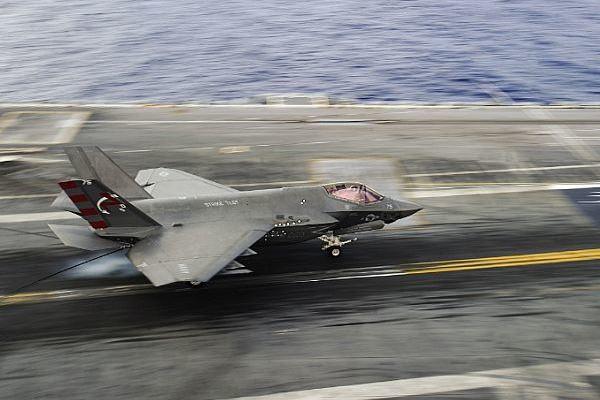ABOARD THE USS GEORGE WASHINGTON--Seven Navy F-35 Joint Strike Fighters spent Monday morning in a round robin off the coast of Norfolk, Virginia, completing a tight succession of take-offs and arrested landings as pilots with Strike Fighter Squadron 101 completed carrier qualifications on the aircraft.
The dozen instructors with the squadron each completed the required 10 traps and two touch-and-go maneuvers in less than two days. But thanks to an advanced landing system in the fifth-generation aircraft that limits the variables pilots need to monitor when they catch the wire, officers with the squadron said they could have gotten the practice they needed in much less time.
"What has traditionally been required for initial qualifications ... that can probably be reduced, because the task becomes mundane after a while," said Lt. Cmdr. Daniel Kitts, officer in charge of the testing detachment aboard this ship. "You can make corrections so easily."
The system that makes the difference is Delta Flight Path, developed by Lockheed Martin Corp. with input from Naval Air Systems Command. That system is one of more than a half-dozen F-35C features that are being tested in this third and final round of carrier exercises.
During a 20-day developmental testing period aboard the George Washington that will conclude Aug. 23, pilots will test the aircraft's ability to fly symmetrical and asymmetrical external weapons loads, execute aircraft launches at maximum weight and against crosswinds, try out a new helmet software load designed to improve visibility in dark conditions, test the capabilities of Delta Flight Path and the Joint Precision Approach and Landing System, and take out and replace an entire F-35C engine to simulate major maintenance aboard a carrier.
At the conclusion of these tests, officials believe the F-35C will be substantially ready for initial operational capability, a milestone the aircraft is expected to hit in 2018.
But success of the built-in carrier landing technology may have even wider-reaching effects.
Like the Maritime Augmented Guidance with Integrated Controls for Carrier Approach and Recovery Precision Enabling Technologies, or MAGIC CARPET, system now being tested on the Navy's legacy F/A-18E/F Super Hornets, Delta Flight Path gives the aircraft the ability to stay on glide slope automatically and minimize the number of corrections the pilot must make.
"All pilots are trained, we make corrections for glide slope with the throttle. We practice it when we get to our fleet trainers, and we practice it a bunch each and every time before we come out to the boat," Kitts said. "So what you're able to do when you come out here is hopefully spend less time practicing, because the workload on the pilot is extremely reduced."
That's important, Kitts said, because time spent in the field and on the carrier practicing landings is time in which pilots are becoming less tactically proficient because they can't develop and drill other skills.
The commanding officer of VFA-101, Capt. James Christie, said pilots are collecting data as they complete their required takeoffs and landings that could be used to inform a prospective proposal to reduce carrier training and qualification requirements.
"We're not going to move too quickly; we're going to ensure it's the right thing to do," Christie said. "But as soon as we have the empirical evidence that shows we can safely reduce those numbers, I'll be all for submitting that to leadership."
So far, the data looks good. In this round of testing, there have so far been no bolters, when an aircraft unintentionally misses the wire, and no landing wave-offs attributed to aircraft performance or safety issues, said Lt. Graham Cleveland, landing signal officer for VFA-101.
Cleveland said this new technology might enable the Navy to cut ashore training from 16 to 18 field carrier landing practices to between four and six. He said he also envisioned cutting carrier qualification requirements from ten to six traps in the future.
"That's going to save money, that's going to save fuel, that's going to save aircraft life, basically," he said.
The future aside, getting out to the carrier for the first evolution of testing to involve operational pilots as well as test pilots was its own milestone for many at the fore of efforts to ready the F-35C for the fleet.
"It's incredibly gratifying to see them come out and really make this aircraft real from the perspective of the fleet," said Tom Briggs, acting chief test engineer for the Navy. "This is going to be a viable program, a viable aircraft that's really going to do what it's designed to do … watching them come out here and do this, it's goose-bumpy."
--Hope Hodge Seck can be reached at hope.seck@military.com. Follow her on Twitter at @HopeSeck.
Related Video:
The U.S. Navy is getting closer to declaring the carrier-variant F-35C ready for combat with a third and final round of carrier testing taking place in August aboard the USS George Washington off the coast of Norfolk, Virginia. (U.S. Navy video)






























